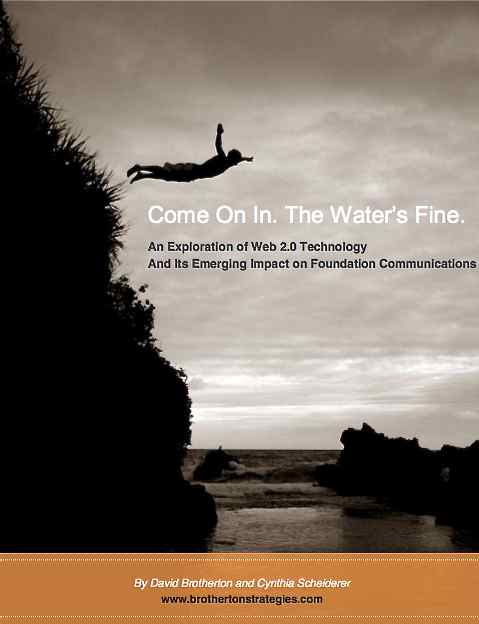
Report Urges Foundations to Make More Use of Web 2.0 and other New Media
A report produced for the Communications Network, released September 22, 2008, urges foundations to make more use of Web 2.0 technologies in order to more effectively engage the public in their work and to have greater programmatic impact.
According to the authors of Come on in. The water's fine. An Exploration of Web 2.0 Technology and its Emerging Impact on Foundation Communications, foundations that have adopted new and still emerging forms of digital communications—interactive Web sites, blogs, wikis, and social networking applications—are finding that they offer "opportunities for focused convenings and conversations, lend themselves to interactions with and among grantees, and are an effective story-telling medium.” The report's authors, David Brotherton and Cynthia Scheiderer, of Brotherton Strategies, who spent nearly a year exploring how foundations are using new media, add that "electronic communications create an opportunity to connect people who are interested in an issue with each other and the grantees working on the issue."

The report also acknowledges that the new technologies raise skepticism and concern among foundations. They include the “worry of losing control over the foundation’s message, allowing more staff members to represent the foundation in a more public way, opening the flood gates of grant requests or the headache of a forum gone bad with unwanted or inappropriate posts.”
Still, the report urges foundations to put aside their worries and make even more forceful use of new media applications and tools. The report argues that whatever is "lost in message control will be more than made up for by the opportunity to engage audiences in new ways, with greater programmatic impact."
The report cautions that by not adopting new ways of communicating, the ability of foundations to contribute to public discussion of important social issues could suffer. “If foundations want to sustain influence among key audiences traditional communication channels simply won’t suffice. To decide not to join the myriad online conversations and networking opportunities is to cede territory to others who may have less means, knowledge or experience. In fact, the loss of ground may already be occurring if we regard a recent survey by the Philanthropy Awareness Initiative that found that more than half of Americans surveyed—who hold a leadership, committee, or board-level role in an organization working on community or social issues—could not name a foundation on their first try.”
Acknowledging that adoption of new media tools will require some cultural and operational shifts in foundations, the reportoffers suggestions from Ernest James Wilson III, dean and Walter Annenberg chair in communication at the University of Southern California, for how to deal with these challenges. He says that for foundations to make the best use of what the technology offers, they should concentrate on three things:
Build up the individual “human capital” of their staffs and provide them the competencies they need to operate in the new digital world.
Make internal institutional reforms to reward creativity and innovation in using these new media internally and among grantees.
Build social networks that span sectors and institutions, to engage in ongoing dialogue among private, public, nonprofits and research stakeholders.
As Wilson also says, “All of these steps first require leadership, arguably a new type of leadership, not only at the top but also from the ‘bottom’ up, since many of the people with the requisite skills, attitudes, substantive knowledge and experience are younger, newer employees, and occupy the low-status end of the organizational pyramid, and hence need strong allies at the top.
The report includes examples and comment from many of the more than 25 foundation senior communications professionals that Brotherton Strategies interviewed, and an assessment of the questions and challenges that new media still pose to the sector.
The report was made possible by support from The California Endowment, the Edna McConnell Clark Foundation, and the Robert Wood Johnson Foundation.
The report, which is featured in a discussion at the Communications Network's Fall 2008 conference in Chicago, can be downloaded from its website. There also will be opportunities to post comments and questions about the report and its findings on the Network's conference blog.
For more information, or to contact Communications Network, click here.



